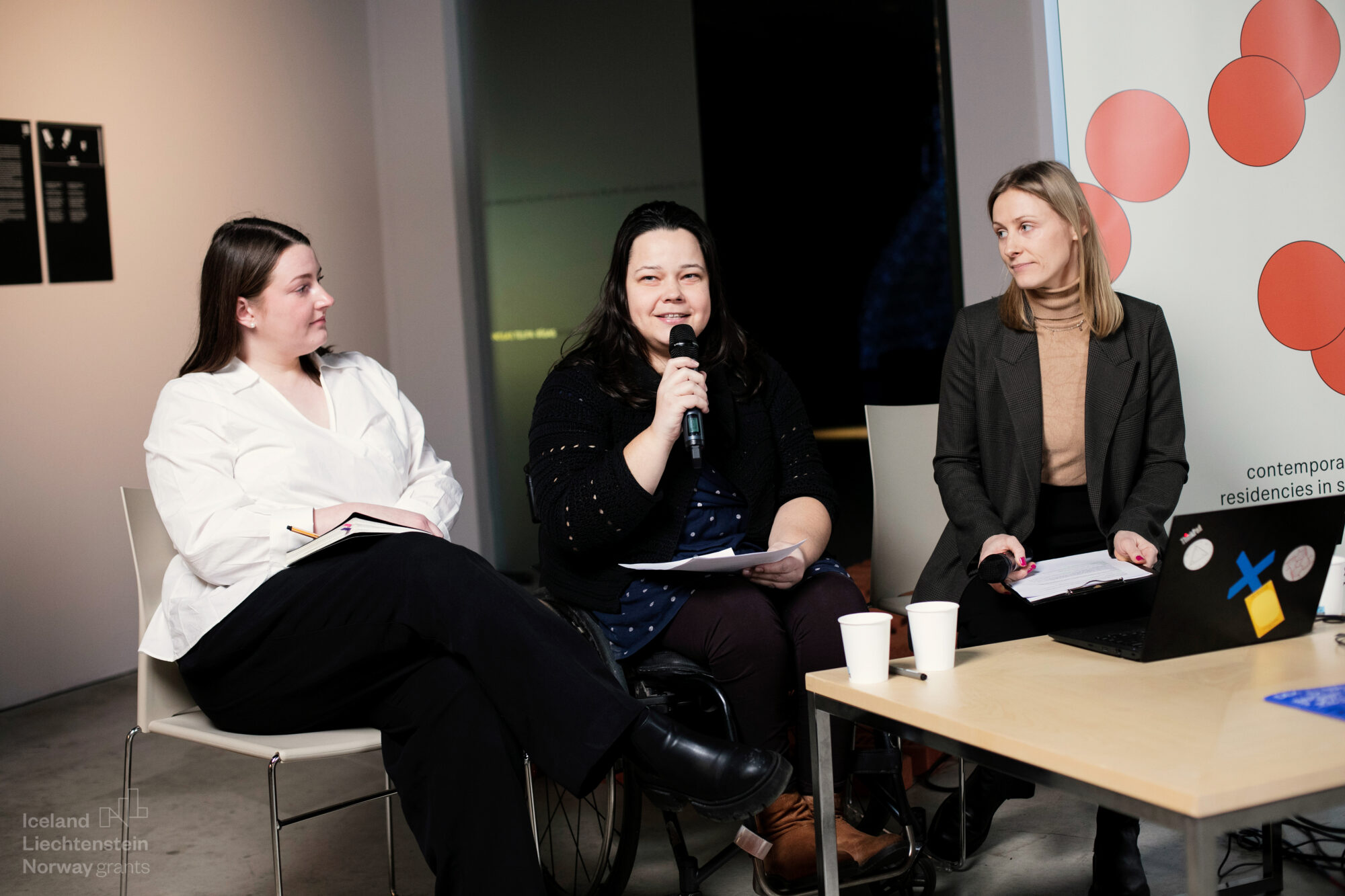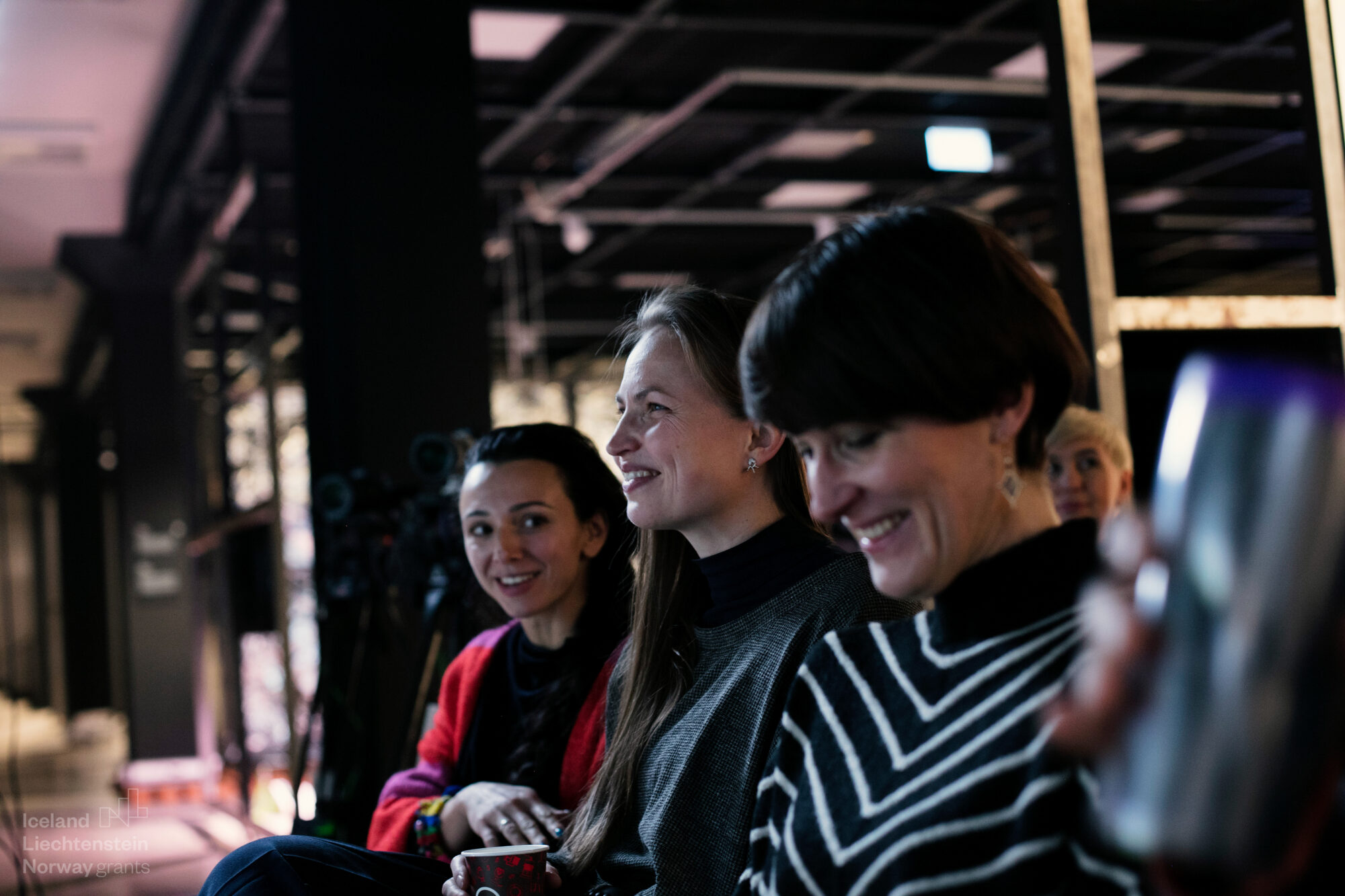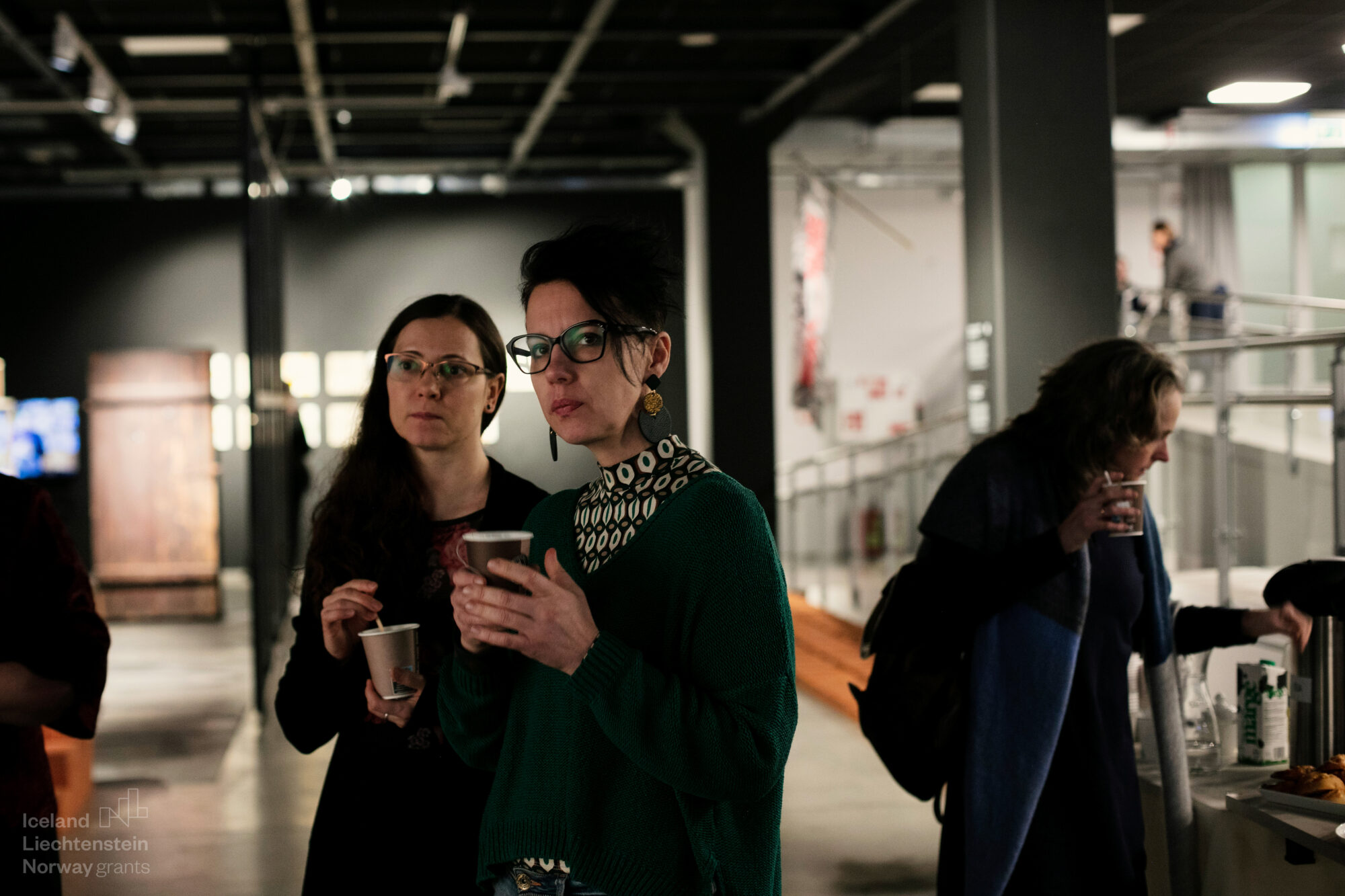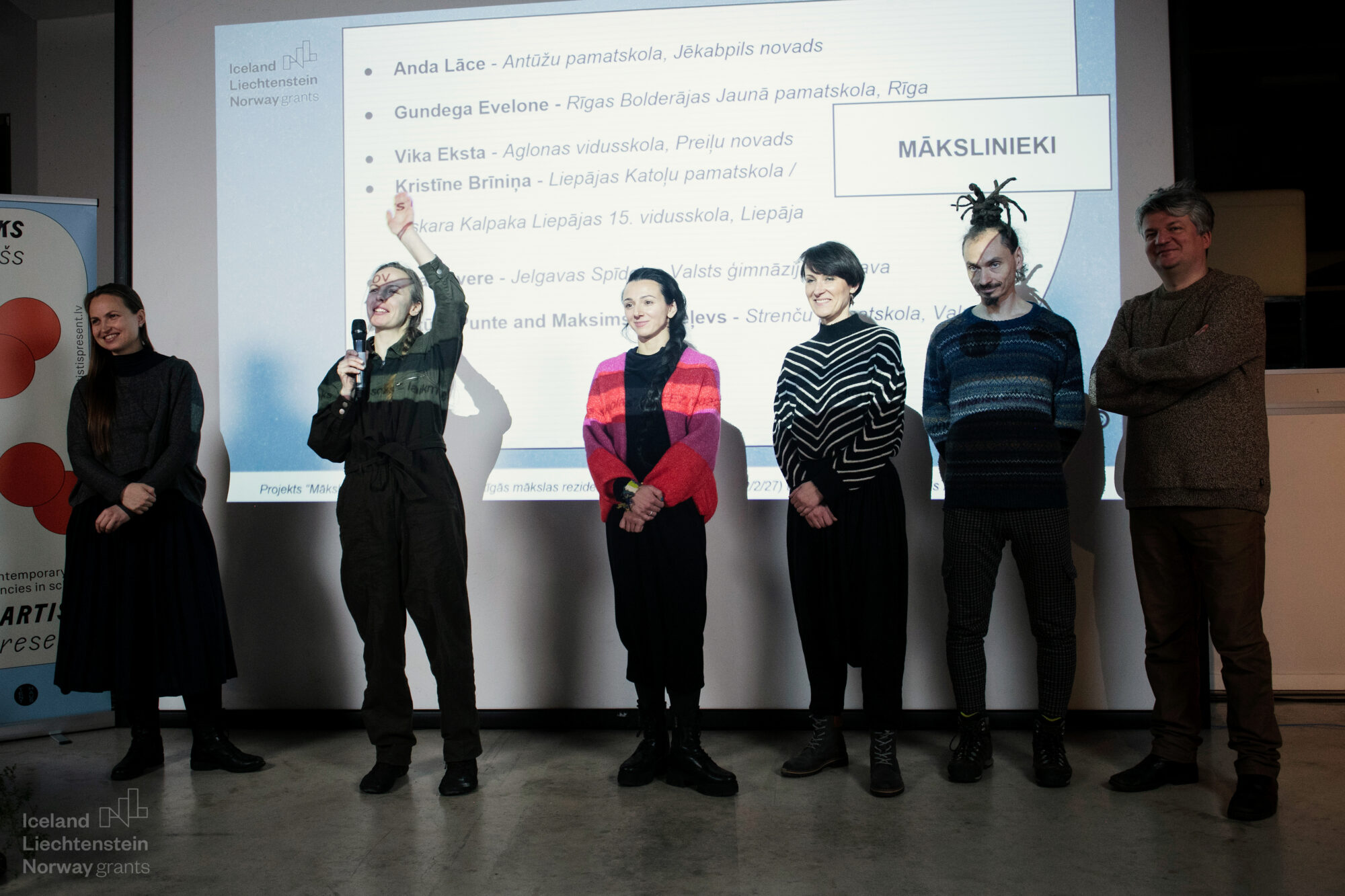February 8, 2023
A look back at the opening conference of the project “The Artist is Present – Contemporary Art Residencies in Schools”
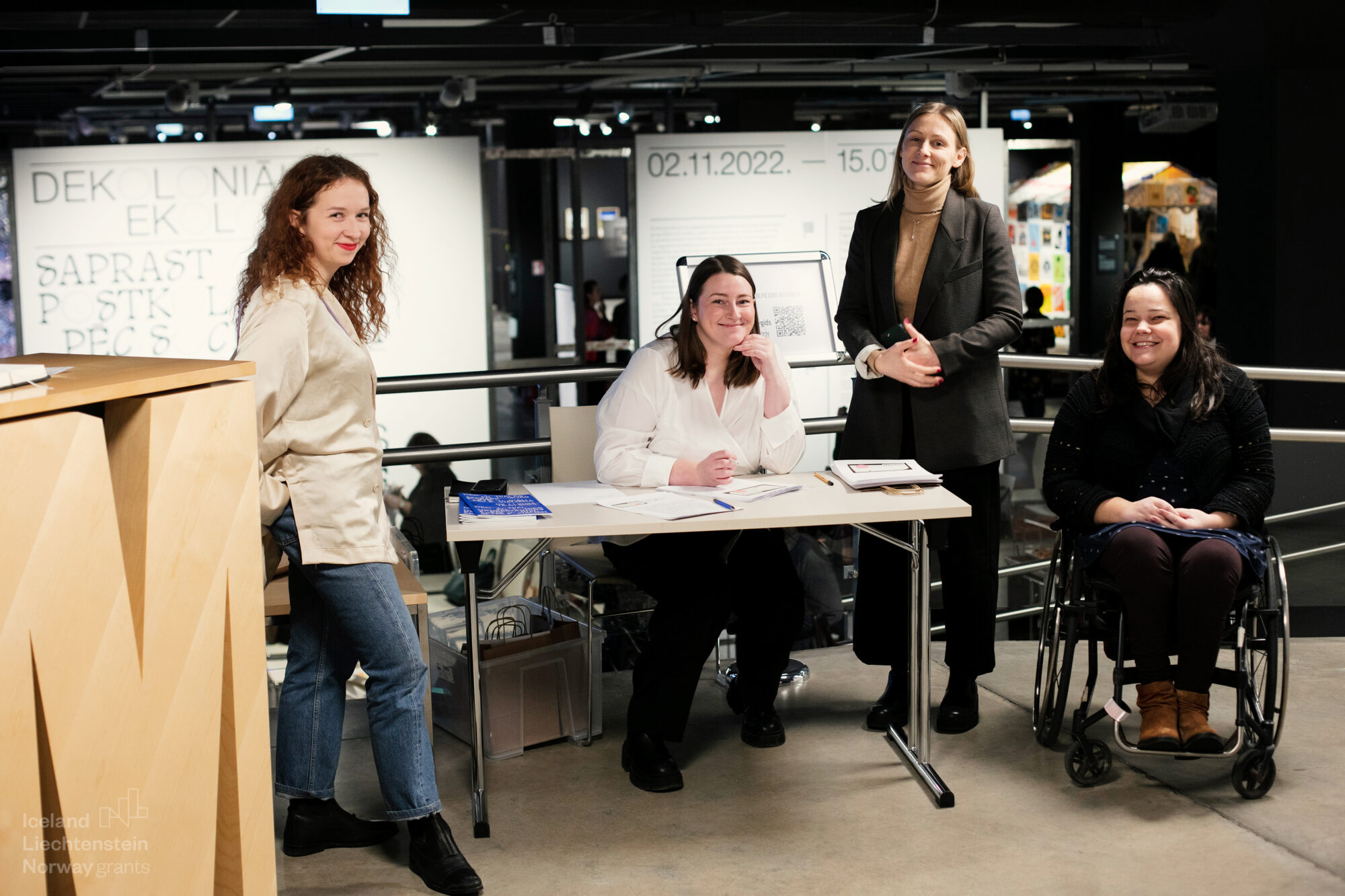
Since autumn 2022, the Latvian Centre for Contemporary Art has been working on the implementation of the project “The Artist is Present – Contemporary Art Residencies in Schools” dedicated to education.
On 12 January this year, the opening event of the project “The Artist is Present – Contemporary Art Residencies in Schools”, launched with the support of the EEA Grants Programme, took place. It took place at the Riga Art Space, at the contemporary art exhibition “Decolonial Ecologies”.
Watch the live video recording of the event here: https://vimeo.com/showcase/10107985
In total, around 50 educators from all over Latvia attended the launch event. In the introductory part, representatives of the Latvian Centre for Contemporary Art Māra Žeikare, Kristīne Ercika and Liba Bērziņa presented the idea, the process and the next steps of the project. The teachers had the opportunity to meet and get to know the artists involved in the project – Kristīni Brīniņa, Vika Eksta, Gundega Evelonis, Anda Lāce, Eva Vēveri, Artūrs Punti and Maksims Šenteļevs.
The introductions were made in a creative and practical way. Each of the artists had prepared a workshop, during which the teachers not only found out what each of the artists involved in the project was doing, but also got an insight into how the lessons will be constructed in schools. After the workshops and the sharing of impressions, the teachers were invited to take a tour of the then ongoing exhibition “Decolonial Ecologies” accompanied by mediators from the Latvian Centre for Contemporary Art.
A little insight into each of the workshops on offer:
In Kristīne Brīniņa workshop, teachers were invited to express their bodily sensations through movement and to think about body memory. The creative exercise was focused on self-discovery and listening to oneself. For example, what does our right hand do in the morning? What is the activity we like to do the most? By connecting the participants’ actions in a continuous series, a great “dance” was created.
The participants said they were very happy with the result. “My feelings were joy at having made a conscious movement and excitement that practically a simple movement made a great performance. There are great things in simplicity, you just have to be aware and listen. For me, it was about listening to everyday movement and to my body,” says Karina.
In Anda Lāce workshop, teachers were asked to recall an episode in the past that they now feel uncomfortable or ashamed to remember, and to present it using movement, story and paper. The paper was more for action than for writing.
In Eva Vēvere workshop, teachers engaged in a magical moment of togetherness by making a collaborative ink drawing of the tree of life on large-format paper. The artist is happy that the intuitively chosen workshop format created a good connection with the Jelgava teachers and the school principal, and with everyone in the group.
The teachers were also deeply drawn into the workshop by artists Artūrs Punte and Maksims Šenteļevs, lingering at the artists’ workbench, on which analogue sound-making tools and various everyday objects were arranged. The workshop uses environmental sensors, sonifies their signals and uses surface microphones to explore the sonic potential of the workshop venue. “I watched the work of sound artists Maksims Šenteļev and Arturas Punte from the sidelines. I don’t know what coincidence brought the two artists together, but it was a great pleasure to see this unique duo in action, to admire their ingenuity and to be delighted that they will be going into schools to inspire students and teachers, to help them discover the diversity of art and science, to get them interested in experimenting and to enjoy the process of creation and collaboration together. Seeing the results of Arthur Punte and Maxim Shentelev’s years of experimentation and academic research – their technical instruments for sound and colour – could be the start of new discoveries for every young person, in art as well as in physics. The main challenge is to unleash the imagination by working and experimenting with wires, containers, water, caps, wind instruments and other objects, letting the imagination run free and filling this experimentation with new and exciting ideas. The resulting technical instrument of sounds and colours is the start of exciting revelations in the exploration of the laws of physics. It offers countless opportunities not only to broaden our horizons, but also to invent and learn new techniques.” (art mediator Ināra Eihenbaum)
The participants of Gundega Evelone workshop used different coloured threads to create a pattern that visually reflected the flow of the Daugava basin from the eastern side of Latvia to its junction with the Gulf of Riga. “After working together, we realised that through art we can strengthen our knowledge of geography and topography, be playful and develop our communication skills by working in a team. I think that after the pandemic phase of online communication, it is important to restore the ability to communicate respectfully and to hear each other in person, which we were able to practise in the Gundega workshop,” says mediator Lana Zujeva.
The real action took place in artist Vika Eksta workshop, where teachers created and presented images based on the polythene bags used in Vika’s exhibition work. Vika’s workshop offered the opportunity to create “one-minute sculptures” out of printed polythene bags – the material used for her own work in the exhibition at the Riga Art Space. Sculptural objects are not destined to last long, but it is enough if the work can be shown for one minute. To complete a one-minute sculpture, one can involve one’s own body and present the work through a pose. The common conversation about the theme of the work, the collaboration and working with the materials offered to bring the ideas to life were at the centre of the workshop, while the result became secondary. The one-minute sculptures were photographed, which became a testimony to the creative process.
We are delighted that the event was well attended and thank all the teachers who let their creativity flow in the workshops with the artists! We send our greetings to the schools with which we will be working more closely. Every teacher is an important element in this project, because it is only by working together and learning about contemporary art that we can change the misunderstanding of it and include it in the school curriculum. Inviting artists to lead workshops in schools will also help teachers to be more successful in their competency-based education processes. “Not all pupils will become artists after taking part in workshops or attending exhibitions, but they will be more creative, more aware of their abilities, more broad-minded. I always provoke the personal creativity of visitors at the LCCA exhibitions.” – Ilze, art mediator.
About the project:
In 2023, seven Latvian artists will spend an extended period of time in schools across Latvia – in Kurzeme, Vidzeme, Zemgale, Latgale, Selija and Riga.
During the project:
- The artists will go on residencies in schools, where they will explore contemporary art with pupils and develop ideas based on research and mutual collaboration, which will result in collective contemporary artworks to be shown at the International Contemporary Art Festival SURVIVAL KIT 14.
- All artists and students involved in the project will also meet at a summer camp in Valmiera in the summer of 2023.
- Already now, Latvian artists, together with the artist collective TENTHAUS from Oslo (Norway), are gaining experience and practical advice on how to work with students and teachers in the long term through a special mentoring programme.
- The results of the project – methods and creative techniques will also be compiled in a special methods material / publication, which will be useful for Latvian teachers in the future when developing content for exploring and integrating contemporary art into the curriculum.
Since 2013, the LCCA has systematically worked on educational programmes for children and young people in its exhibitions and the SURVIVAL KIT festival, creating guides, printed materials, excursions and workshops. In 2019, with the support of the State Culture Capital Foundation’s target programme “Creating content for the Latvian school bag”, the LACCA launched the project “With class to masterclass!”, taking 11 different artists to more than 30 schools across Latvia, with a special response in regions where contemporary art is hardly accessible. The idea of the project “The Artist is Present” is based on the experience gained on these trips and the artists’ desire to build a closer and more lasting relationship with the school audience.
The artists participating in the project are Kristīne Brīniņa, Vika Eksta, Gundega Evelone, Anda Lāce, Eva Vēvere, Artūrs Punte and Maksims Šenteļevs.
The project manager is Māra Žeikare.

.....
